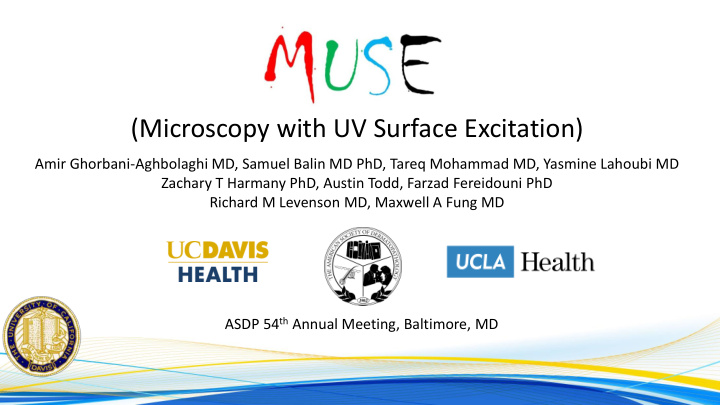



MUSE (Microscopy with UV Surface Excitation) Amir Ghorbani-Aghbolaghi MD, Samuel Balin MD PhD, Tareq Mohammad MD, Yasmine Lahoubi MD Zachary T Harmany PhD, Austin Todd, Farzad Fereidouni PhD Richard M Levenson MD, Maxwell A Fung MD ASDP 54 th Annual Meeting, Baltimore, MD
Disclosure Dr. Richard Levenson is co-founder and CEO of MUSE Microscopy Inc. Remaining authors declare no conflicts of interest
Pathology
Pathology Conventional microscopy Require traditional fixation, thin-sectioning and staining
Pathology Conventional microscopy Require traditional fixation, thin-sectioning and staining Ex-vivo microscopy (Slide-free) Rapid imaging of biopsy material
Pathology Conventional microscopy Require traditional fixation, thin-sectioning and staining Ex-vivo microscopy (Slide-free) Rapid imaging of biopsy material In-Vivo microscopy (Biopsy-free) Evaluation of human tissue microstructure in real time
What is MUSE? A novel Ex-Vivo microscopy Slide-free method developed at UC Davis First in evaluating on human tissue Microscopy with UV Surface Excitation (MUSE) Using UV-emitting LED with wavelength of 275 to 285 nm Digital camera captures the excitation light
How MUSE works? Ultraviolet (UV) is an electromagnetic radiation Wavelength: 10 nm to 400 nm (Shorter than visible light)
How MUSE works? Ultraviolet (UV) is an electromagnetic radiation Wavelength: 10 nm to 400 nm (Shorter than visible light) The light penetration depth is depends on the wavelength
How MUSE works? Ultraviolet (UV) is an electromagnetic radiation Wavelength: 10 nm to 400 nm (Shorter than visible light) The light penetration depth is depends on the wavelength 275 to 285 nm UV light has penetrate depth of 3 microns Approximately the thickness of a conventional tissue section
How MUSE works? UV light can excite dyes or endogenous auto-florescent materials The emission light varies from blue to red
How MUSE works? UV light can excite dyes or endogenous auto-florescent materials The emission light varies from blue to red A digital camera can capture the emitted lights 3 microns thickness from the surface of the specimen The images must be similar to H&E but in full color
MUSE setup:
MUSE setup: Prepare flat tissue surface Staining (50 sec total) Rhodamine B, Hoechst 33342 Eosin Propidium iodide Capture images
Normal Histology
Normal Histology
Normal Histology
MUSE: Diagnostic value 1 Verruca Vulgaris Epidermal Lesions 2 AK, Acantholytic and hypertrophic 3 Bowen’s Melanocytic Lesions 4 SCC KA type 5 SCC in dermis 30 selected Pilar & Sebaceous 6 BCC superficial cases 7 BCC nodular 8 Pig nodular BCC Cysts 9 BCC infiltrative 10 Pig Seborrheic keratosis Elastin
MUSE: Diagnostic value Epidermal Lesions 11 IDN 12 Compound Nevus Melanocytic Lesions 13 Lentiginous Nevus 30 selected 14 Blue Nevus Pilar & Sebaceous 15 Spitz Nevus cases 16 MIS Cysts 17 MM Elastin
MUSE: Diagnostic value Epidermal Lesions 18 Sebaceous hyperplasia Melanocytic Lesions 19 Nevus Sebaceous 20 Pilomatricoma 30 selected Pilar & Sebaceous 21 Cylindroma cases 22 Poroma Cysts 23 Mixed tumor 24 Syringoma Elastin
MUSE: Diagnostic value Epidermal Lesions Melanocytic Lesions 25 Hidrocystoma 30 selected 26 Steatocystoma Pilar & Sebaceous cases 27 Pilar Cyst 28 EIC Cysts 29 PXE Elastin 30 Solar elastosis
MUSE: Scoring Diagnostic score: Percentage of correct diagnosis of each MUSE image Comparison score: Assessed by the concordance between MUSE images and correlated H&E images generated by whole slide scanner
MUSE: Diagnostic score What is this? Total Dx score: 70.83% Cystic lesions: 88% Epidermal lesions: 80% Adnexal lesions: 79% Melanocytic: 46% Elastin lesions: 62%
MUSE: Comparison score Is it better than H&E?
BCC
IDN
Compound Nevus
Blue Nevus
Spitz Nevus
Melanoma
Nevus Sebaceous
Pilomatricoma
Cylindroma
Poroma
Syringoma
Hidrocystoma
Steatocystoma
PXE
MUSE: Comparison score Is it better than H&E? Total C. score: 0.8 Cystic lesions: 1.2 Adnexal lesions: 1.0 Elastin lesions: 1.0 Epidermal lesions: 0.7 Melanocytic: 0.6
MUSE vs H&E:
MUSE vs H&E: Cons: Pre-image: Unable to changing magnifications Hard to work with very small specimens Image: Nuclear features (melanocytic, inflammatory) Unfamiliar colors Post-image: Large data Tissue storage
MUSE vs H&E: Pros: Robust method Simple physical & chemical principles Fast (2 minutes) Fresh, formalin or alcohol MUSE images: Multi-color (more informative) 3 Dimensional Similar to H&E (orientation/thickness) High diagnostic value (even for fresh eyes)
MUSE vs H&E: Pros: Ex-vivo microscopy: Inexpensive (No histology) Preserving tissue (downstream molecular testing) Potential use in intraoperative consultation Can potentially be used as POC Digital pathology: Provide service to low resource areas
MUSE vs H&E: Pros: Its BEAUTIFUL
MUSE vs H&E: Pros: Its BEAUTIFUL
MUSE now:
MUSE future?
MUSE future?
MUSE future? @BSTPath @FungMaxwell
Our team: Maxwell A Fung MD Richard Levenson MD Samuel Balin MD PhD Tareq Mohammad MD
Our team: Farzad Fereidouni PhD Yasmine Lahoubi MD Zachary Harmany PhD Austin Todd
Thank you …
Thank you …
Recommend
More recommend